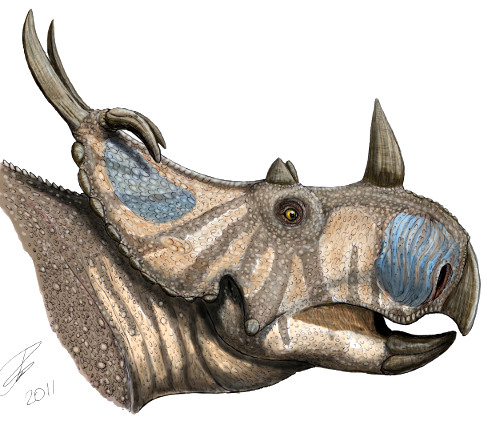
The Victim - Spinops sternbergorum (artistic reconstruction by Dmitry Bogdanov, image from Science 2.0 story)
I don’t use this blog as a platform to rant very often, but a story published on Gawker this afternoon has me all riled up.
In “Moron Paleontologists Find New Species of Dinosaur in Their Own Museum“, author Max Read decides he’s fully qualified to judge how paleontology and taxonomy in general should be done, and criticizes a team of paleontologists for doing something every taxonomist does; study material housed in a museum. That’s right, Mr. Read snidely mocks the authors, who described a very cool new dinosaur species, for not undertaking a grand expedition to parts unknown to find this new species, instead discovering the species while re-examining specimens housed in the British Natural History Museum’s basement collections.
Nevermind the function of a museum is not just to provide a place for ignoramuses like Mr. Read to potentially learn something about natural history and gawk at fantastic displays, but also to actually house the raw data of biology; specimens. Or that people studying specimens in museums would much rather be exploring exotic new localities but are handcuffed by a critical lack of monetary support for taxonomy, which cuts our ability search for new specimens (which are then brought back to the museum and ultimately stored, although I guess that fact never occurred to Mr. Read either). Or indeed that the process of taxonomy is not as straightforward as looking at a single specimen (or pieces of a specimen as is the case in much of paleontology) and instantly recognizing it as unique and in need of a new name.
The true shame of all this is the fact that the blog network Mr. Read writes for is composed of a number of blogs which routinely write well-versed and well-researched pieces on science and technology (io9 & Gizmodo to be precise). How this fascinating story was forwarded onto Mr. Read and not to authors in those other fine networks who I’m sure could have done it justice is almost as outrageous as Mr. Read’s story itself.
Natural history collections are one of the most valuable resources we have as a society, providing a link to the world around us, and to believe that people shouldn’t be studying the material contained within them is like believing that libraries shouldn’t be used for fact checking. Oh, wait…
(If you want to see how science journalism SHOULD be done, I encourage you to read Science 2.0’s version of the story)
